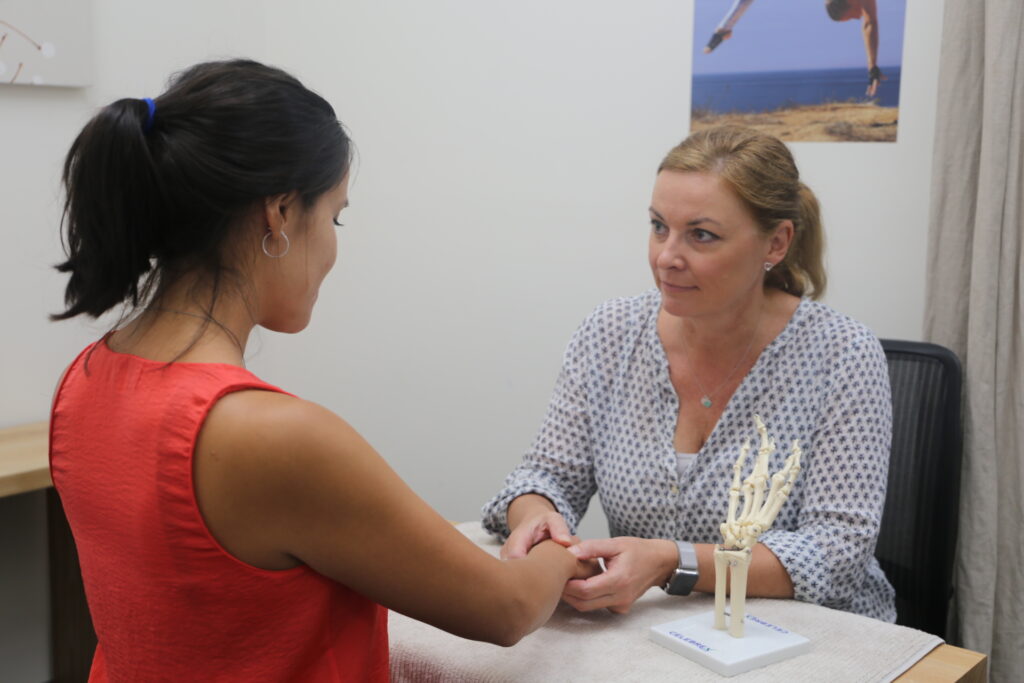Motherhood is an incredible journey, full of countless joys and challenges. However, one aspect that often goes unnoticed is the physical toll it takes on a woman’s body. Childbirth can cause a range of health issues, including hand and wrist pain, also known as “mother’s wrist.” This condition can significantly impact a new mother’s ability to care for her child and perform daily tasks. Here’s a detailed look at the causes, symptoms and treatment options for mother’s wrist, helping new mothers cope with this condition.
Causes of Mother’s Wrist
“Mother’s wrist” and “mother’s thumb” are common conditions that affect new mothers. Mother’s wrist is caused by repetitive hand and wrist movements, such as lifting and holding a baby, carrying heavy items or pushing a stroller. These movements can cause inflammation and swelling in the wrist tendons, leading to pain and discomfort.
Symptoms of Mother’s Wrist
The symptoms of mothers wrist can vary from person to person. Some common symptoms include pain, swelling, stiffness and weakness in the wrist. The pain can be felt in the wrist, hand and forearm, making it difficult to perform daily tasks such as lifting and carrying objects, typing on a keyboard, or even holding a mug of coffee. In severe cases, mother’s wrist pain can radiate up the arm and cause numbness or tingling in the fingers.
Treatment Options for Mother’s Wrist
Thankfully, there are several treatment options available for mothers wrist. The first step is to rest the affected wrist, avoiding any activities that cause pain. Applying ice to your wrist can help to reduce swelling and inflammation. Wearing a wrist brace or splint can also provide support and help relieve pressure on the affected tendons.
Physiotherapy can also help treat mother’s wrist. An MGS physiotherapist can teach exercises to strengthen the wrist and improve flexibility. They can also provide guidance on proper lifting techniques and posture to prevent further injury.
Hand therapy is another helpful specialism for treating mother’s wrist. Hand therapy combines occupational therapy and physiotherapy to tailor your unique treatment program.
Pelvic floor physiotherapy is another helpful therapy for new mothers. With real-time ultrasounds, internal assessments, exercise programs and more, our specialised pelvic floor physiotherapists will put you at ease and address pelvic floor problems quickly.
In some cases, medication may be prescribed to help manage the pain and reduce inflammation. Over-the-counter pain relievers such as ibuprofen or acetaminophen can also be helpful.
Diagnosing Mother’s Wrist
If you are experiencing wrist pain, stiffness, or weakness after giving birth, you should consider seeing a doctor. They will perform a physical exam to assess the extent of the injury and may order imaging tests such as an X-ray or MRI to rule out other conditions.
It is important to seek treatment for mother’s wrist as soon as possible to prevent the condition from worsening. Left untreated, mother’s wrist can lead to chronic pain and long-term damage to the tendons and nerves in the wrist and hand.
Preventing Mother’s Wrist
Preventing mothers wrist is essential, especially for new mothers at higher risk of developing the condition. One way to avoid mother’s wrist is to practise proper lifting techniques when carrying a baby or other heavy objects. This includes keeping your wrist straight and using the strength of the arms and legs to lift rather than relying on the wrist.
Taking frequent breaks and stretching the hands and wrists can also help to prevent mother’s wrist. Using a supportive pillow or cushion when breastfeeding can also help to reduce strain on the wrists.
Mother’s Wrist Exercises
Several exercises can help treat mother’s wrist. Some of them are:
1. Wrist stretches
- Hold your arm out in front of you with your palm facing down.
- Use your other hand to gently pull your fingers towards you, stretching the wrist.
- Hold the stretch for 15-30 seconds and then release.
- Repeat this stretch around 5 times on each wrist.
2. Grip strengthening exercises
Squeezing a soft ball or a hand gripper can help strengthen the wrist muscles and improve grip strength.
- Hold the squeeze for 5-10 seconds and then release.
- Repeat this exercise around 15 times on each hand.
3. Wrist rotations
- Hold your arm out in front of you with your palm facing down.
- Rotate your wrist in a circular motion, first clockwise and then counterclockwise.
- Repeat this exercise around 15 times on each wrist.
4. Finger extensions
- Hold your arm out in front of you with your palm facing down.
- Spread your fingers apart and hold for 5-10 seconds.
- Then, bring your fingers together and hold for 5-10 seconds.
- Repeat this exercise 10-15 times on each hand.
Mother’s wrist is a painful and uncomfortable condition that can significantly impact a new mother’s ability to care for her child. However, with proper treatment and prevention, mothers can manage the symptoms of this condition and continue to enjoy the joys of motherhood.
Need physiotherapy treatment for mother’s wrist? Book now at MGS Physiotherapy and start your journey to recovery today.
CALL NOW TO BOOK YOUR APPOINTMENT

